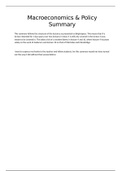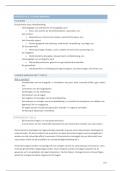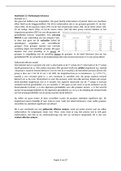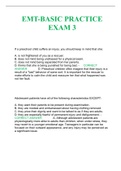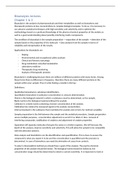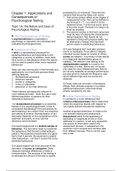Summary
This summary follows the structure of the lectures as presented on Brightspace. This means that if a
lecture intended for 1 day spans over two lectures in total, it is still only covered in the lecture it was
meant to be covered in. This takes a bit of a creative liberty in lecture 9 and 10, where lecture 9 focusses
solely on the work of Anderson and lecture 10 on that of Wintrobe and Mansbridge.
I want to express my thanks to the teacher and fellow students, for this summary would not have turned
out the way it did without their presentations
,Lecture 1 Seigniorage and Political instability
Cukierman, Edwards and Tabellini (1992)
This course doesn’t just focus on optimality issues, but takes political economy and public choice into
account as well. We don’t show how e.g. optimal taxes are derived, but the level of taxes that are
derived given the policymakers’ interests and the corruption levels of the government.
- political instability
- intertemporal optimization & policy implications
- political budget and forecast cycles
The first set of 4 lectures covers topic 1, which asks the question: how does political instability affect
monetary and fiscal policy?
- myopic behavior leads to short-run policies
- seigniorage versus deficit
- the effect of grand corruption on monetary and fiscal policy
- cheating governments may prevent cheating from central banks
What do you need to know for this course:
- a theoretical understanding of the discussed mechanisms
- the empirical applications and case studies of the given mechanisms
- the policy recommendations that can be derived from
The article of Cukierman, Edwards and Tabellini focusses on seigniorage, tax reform and political
instability. They argue that political instability can lead to strategic postponement of tax reform, which
can lead to a reliance on seigniorage.
Their main argument is this: if there is political instability it is strategic to postpone a tax reform and
better to rely on seigniorage.
Let’s see why. First off, they observe correlation between inflation and seigniorage.
- seigniorage is the monetary gain a government receives from printing money. They make extra money
to pay of their debt. Logically, this leads to a higher money supply and thus there is higher inflation when
the market can catch up.
- Seigniorage is a measure of the monetary solidity of a country. It varies per country by a lot. In Bolivia,
the percentage is 21% while in the Netherlands that is only 2%.
Why are there differences in inflation and seigniorage between countries? It usually comes down to lax
monetary and fiscal policies.
- lax monetary policies make it so that there is no stress on printing out more money. Because of the
assumption of money neutrality on the long-run, this means lax monetary policy leads to high levels of
inflation on the long-run.
,- lax fiscal policies make it so that the government tries to play tricks to abuse monetary policy so they
finance their debt through seigniorage. The debt a government creates is bordered by the central bank.
Increased lax fiscal policy leads to increasing seigniorage.
Okay, so now we know inflation and seigniorage vary per country based on how lax their monetary and
fiscal policy are. Then becomes the question: why are some countries laxer in their polices?
- traditionality, this comes down to the development of tax systems and the costs of enforcing tax
payment. If it is more expensive to enforce tax payment or develop a good tax system, a government will
need to rely on seigniorage to repay it’s debt.
- Another situation that plays a role are the political conditions of a country. When a country is more
politically unstable, this often leads to higher levels of seigniorage as well. In the paper from Cukierman,
Edwards and Tabellini, this link plays a central part.
To investigate why political instability leads to seigniorage, we need to make a distinction between
fiscal policy and the tax system
- fiscal policy tackles the tax rate and the composition of government revenue. This decision is
contemporaneous, meaning you can change things over time.
- tax system describes how changes requires a tax reform. It focusses on a more long-term perspective.
It takes lag effects into consideration and changes do not occur in the same period as they are made.
basically: you can choose to increase or decrease tax, but they way tax is collected takes time to
adjust
Political instability is based on two different factors.
- political uncertainty describes a government’s chance to fail and lose power.
- Political uncertainty is tied to not knowing if you will be in power next period.
- It is increased when a future government is very different from you.
- Say you are performing sub-par and you risk being replaced by a future government.
If that future government looks very alike to you, there is not much incentive for the
civilians to drop the current government for a near-identical copy of the current
government. However, if the next government is nothing like the current
government, they might want to make more work out of expelling you from the
current government.
- Think of it like an American election: a republican is more likely to be voted off when
there is a good democrat alternative then another republican alternative
- political polarization has to do with the cultural differences within a society
- this includes things like ethnicity and religions
- how united are people within your society
- socio-political perspectives higher and lower class systems
, Another important term to take into account is myopic behavior. Myopic behavior describes the present
bias of a government. This behavior is increased when the future for a government is uncertain.
Therefore, if political uncertainty is higher, myopic behavior is higher as well.
when a government is uncertain if they are in power next period, their attention shifts towards the
period where they are in power for certain: the current period.
What does myopic behavior mean for government choices?
- future uncertain, so focus on present benefits
- no investments in the future, as other governments with different interests might benefit from your
investment
- incentive to focus on the present, not on future investments
- clashing of short-term desires and plans with long-term goals and optimality
- also focus on short-term benefits for the public so there is a bigger chance to be re-elected
- lower taxes and no tax reform despite inefficiencies in the tax system
- higher seigniorage
- no tax reform
- nonetheless, they have to get revenue from something
- government can either finance via taxes (τ) or via seigniorage (s)
So: political instability leads to seigniorage through myopic behavior.
This is backed up empirically as well in their paper. They explain seigniorage through two models:
model 1: economic factors
- looks at the development of a tax system and the cost of enforcing tax payments
- 33 - 42% of variation explained
- measured by capita income and economic sectors respectively
- no problem
model 2: economic factors AND political factors
- also looking at political factors (like political instability, uncertainty and polarization) on top of
economic factors
- problem 1: how can you measure political uncertainty?
- their solution: construct a measure of P and Ps
- problem 2: how can you measure political polarization?
- their solution: use proxies
- problem 3: there is probably reverse causality
- seigniorage could also lead to political uncertainty, not necessarily that pol. Unst. Leads
to seigniorage
- their solution: you need to use an instrumental variable to tackle this
However, these models are not flawless. Let’s discuss some of the problems with their analysis.
- problem 3: the reverse causality issue
- not clear how the instrumental variables are obtained
- they should be uncorrelated with the error term, but no evidence of that is shown

